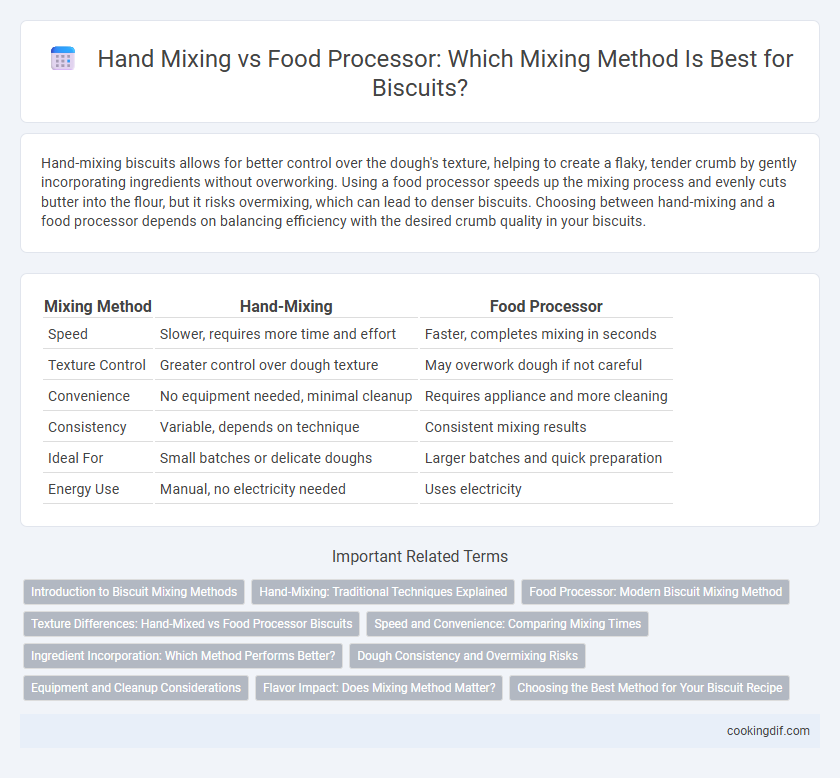Hand-mixing biscuits allows for better control over the dough's texture, helping to create a flaky, tender crumb by gently incorporating ingredients without overworking. Using a food processor speeds up the mixing process and evenly cuts butter into the flour, but it risks overmixing, which can lead to denser biscuits. Choosing between hand-mixing and a food processor depends on balancing efficiency with the desired crumb quality in your biscuits.
Table of Comparison
| Mixing Method | Hand-Mixing | Food Processor |
|---|---|---|
| Speed | Slower, requires more time and effort | Faster, completes mixing in seconds |
| Texture Control | Greater control over dough texture | May overwork dough if not careful |
| Convenience | No equipment needed, minimal cleanup | Requires appliance and more cleaning |
| Consistency | Variable, depends on technique | Consistent mixing results |
| Ideal For | Small batches or delicate doughs | Larger batches and quick preparation |
| Energy Use | Manual, no electricity needed | Uses electricity |
Introduction to Biscuit Mixing Methods
Hand-mixing biscuits allows precise control over dough texture by gently incorporating ingredients to maintain flakiness, while a food processor speeds up the process by quickly blending cold butter and flour, ensuring a tender crumb. The choice between methods affects the biscuit's rise and texture, with hand-mixing favoring a rustic, flaky result and food processors producing consistent, uniform dough. Understanding these mixing techniques helps bakers achieve desired biscuit qualities tailored to specific recipes.
Hand-Mixing: Traditional Techniques Explained
Hand-mixing dough for biscuits offers precise control over texture by allowing gradual incorporation of ingredients, preserving the delicate crumbly structure essential to classic biscuits. This traditional technique prevents overworking the dough, which can result in tough, dense biscuits instead of tender, flaky layers. Mastering hand-mixing ensures a superior biscuit texture through careful blending of butter and flour without overheating or excessive agitation.
Food Processor: Modern Biscuit Mixing Method
Food processors offer a modern biscuit mixing method that ensures consistent dough texture by rapidly combining ingredients while minimizing overworking. This technique produces tender, flaky biscuits by swiftly cutting cold butter into the flour, preserving distinct butter pockets essential for flakiness. Food processors reduce preparation time and improve accuracy, making them ideal for both home bakers and commercial kitchens aiming for reliable biscuit quality.
Texture Differences: Hand-Mixed vs Food Processor Biscuits
Hand-mixed biscuits often have a coarser texture due to the larger, unevenly distributed fat pieces that create a flakier, more tender crumb. Food processor biscuits typically result in a finer, more uniform dough consistency, producing a denser and less flaky biscuit texture. The choice of mixing method directly influences the biscuit's crumb structure, with hand-mixing enhancing lightness and flakiness.
Speed and Convenience: Comparing Mixing Times
Hand-mixing biscuits typically takes 5 to 7 minutes, providing greater control over dough texture but requiring more manual effort. Food processors can mix biscuit dough in under 2 minutes, offering significant speed and convenience for busy kitchens. Choosing between methods depends on balancing time efficiency with the desired dough consistency.
Ingredient Incorporation: Which Method Performs Better?
Hand-mixing gently combines butter and flour, preserving small butter flakes crucial for creating flaky biscuit layers. Food processors rapidly mix ingredients, risking overworking the dough and causing dense biscuits due to excessive gluten development. For optimal ingredient incorporation that balances thorough mixing and texture preservation, hand-mixing typically performs better in biscuit preparation.
Dough Consistency and Overmixing Risks
Hand-mixing biscuit dough allows greater control over dough consistency, producing a tender texture by gently combining ingredients without overworking gluten. In contrast, using a food processor mixes ingredients quickly but risks overmixing, which can lead to tough, dense biscuits due to excessive gluten development. Achieving optimal biscuit dough requires balancing mixing speed and technique to maintain flakiness and lightness.
Equipment and Cleanup Considerations
Hand-mixing biscuits requires minimal equipment--typically a bowl and a pastry cutter or fork--resulting in easier cleanup with fewer utensils to wash. Food processors speed up the mixing process using blades and a motorized unit, but they involve more components such as the bowl, lid, and blade attachment that demand thorough cleaning to remove dough residue. Choosing hand-mixing reduces the number of items to clean, while a food processor offers efficiency at the cost of increased equipment maintenance.
Flavor Impact: Does Mixing Method Matter?
Hand-mixing biscuit dough incorporates air more gently, preserving distinct flour and butter particles that enhance flaky texture and rich flavor, while food processors tend to overwork the dough, potentially leading to a denser crumb and muted taste. Studies show that hand-mixed biscuits often achieve a superior mouthfeel due to less gluten development, which positively influences flavor release during baking. Choosing the mixing method directly affects the balance of texture and flavor, making hand-mixing preferable for artisanal biscuit quality.
Choosing the Best Method for Your Biscuit Recipe
Hand-mixing biscuits offers greater control over dough texture, preventing overmixing and ensuring tender, flaky layers, ideal for traditional recipes. Food processors provide speed and consistency, quickly blending cold butter into flour for a uniform crumb structure in large batches. Selecting the best method depends on recipe specifics, desired biscuit texture, and preparation time constraints.
Hand-mixing vs food processor for mixing method Infographic

 cookingdif.com
cookingdif.com